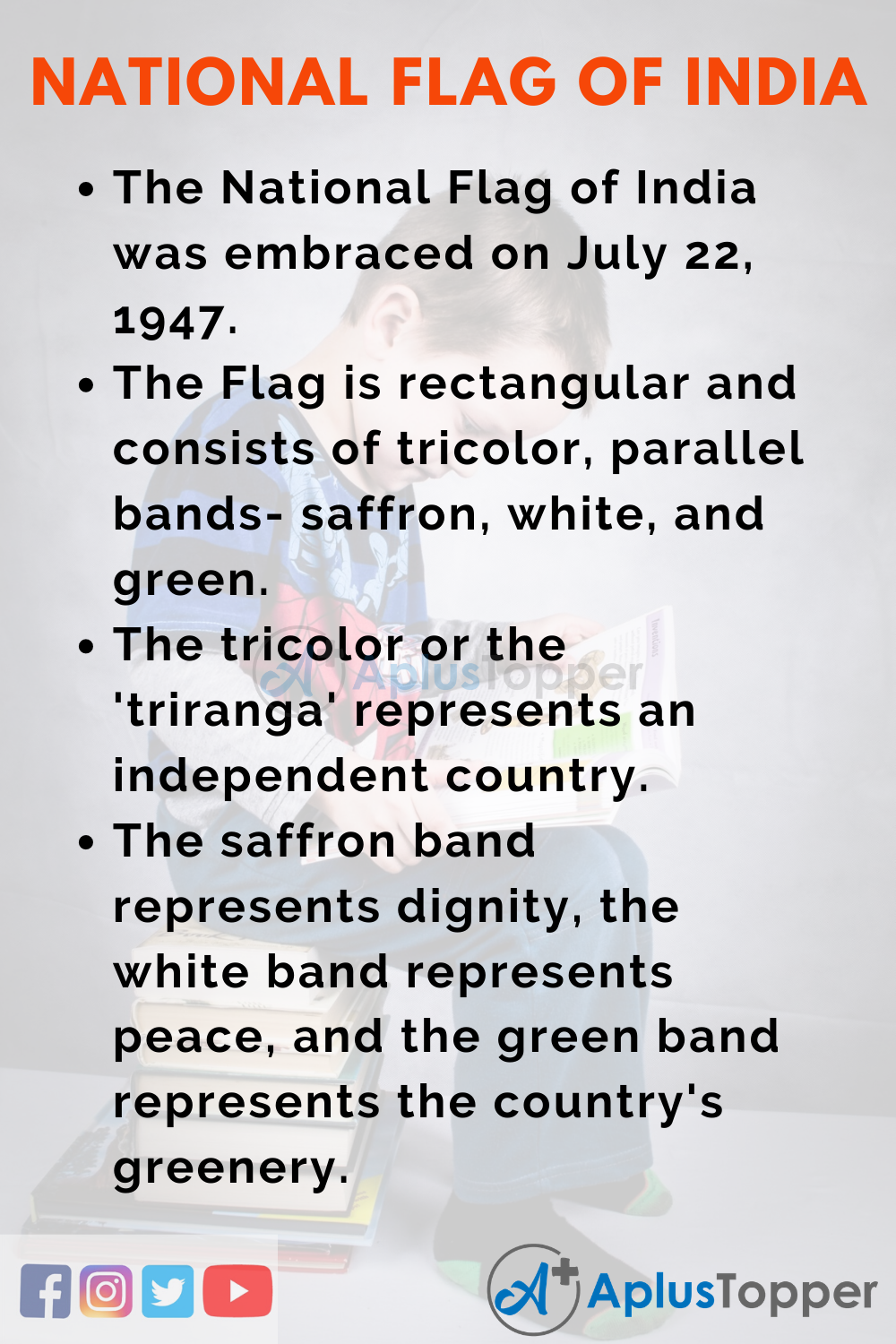10 Lines on National Flag of India: The National Flag of India is a matter of pride to all Indians citizens, including the NRIs. The National Flag of India was adopted by the Indian Constituent Assembly on July 22, 1947. The Flag was adopted as the Flag of the Dominion of India. On January 26, 1950, the Flag was retained as the Flag of the Republic of India, when the Constitution came into effect.
The National Flag of India is a rectangular flap, referred to as the ‘triranga’ or the tricolor. The tricolor represents unity and strength and is a symbol of India’s freedom.
The National Flag consists of three colors- Saffron, white and green with a blue chakra in between. The spinning wheel represents self-sufficiency through the use of domestic products. The below-mentioned ten lines will help you formulate paragraph writings and essays about the National Flag of India.
You can read more 10 Lines about articles, events, people, sports, technology many more.
Set 1 – 10 Lines on National Flag of India for Kids
Set 1 is helpful for students of Classes 1, 2, 3, 4 and 5.
- The National Flag of India was embraced on July 22, 1947.
- The Flag is rectangular and consists of tricolor, parallel bands- saffron, white, and green.
- The tricolor or the ‘triranga’ represents an independent country.
- The saffron band represents dignity, the white band represents peace, and the green band represents the country’s greenery.
- The center of the National Flag consists of a blue Chakra called the Ashok Chakra with 24 spiked wheels.
- The Ashok Chakra represents truth or ‘dharma’ and resembles Gandhiji’s spinning wheel
- The National Flag was designed by Pingali Venkayya as the “Swaraj Flag.”
- The material of the National Flag of India is made of Khadi cotton or Khadi silk.
- The Nation Flag is highly respected, and any insult leads to punishable offense by law.
- The Flag Code of India 2002 governs and regulates the National Flag of India.

Set 2 – 10 Lines on National Flag of India for School Students
Set 2 is helpful for students of Classes 6, 7 and 8.
- The National Flag of India was designed by Pingali Venkayya, as the Swaraj Flag.
- The concept of the Swaraj Flag was adopted from Mahatma Gandhi’s proposal to Swaraj Flag to Indian National Congress in 1921.
- The National Flag of India was adopted on July 22, 1947, and as the Flag of the Republic of India on January 26, 1950.
- Th Flag represents India as an independent and democratic country.
- The National Flag is a rectangular shape material. It comprises of tricolor parallel widths- saffron, white, and green.
- The saffron color represents courage and courage. The white color represents peace and truth, and the green color represents fertility and growth.
- The Flag consists of a Navy-blue 24-wheeled Chakra known as the Ashokan Chakra and represents the principle of life and the twenty-four hours in the day,
- The National Flag of India should be revered, and any comment or insult is a punishable offense by law.
- The National Flag unites the diverse cultures of different religions in one thread of brotherhood.
- Every Indian citizen must safeguard and protect the National Flag of its dignity and honor.
Set 3 – 10 Lines on National Flag of India for Higher Class Students
Set 3 is helpful for students of Classes 9, 10, 11, 12 and Competitive Exams.
- The National Flag of India symbolizes India’s pride and represents the aspirations of all Indians.
- The National Flag was adopted on July 22, 1947, and symbolized Democracy in India.
- The National Flag is hoisted by the Prime Minister on occasions such as the Republic Day on January 2, the Independence Day on August 15, and the Gandhi Jayanti on October 2 every year.
- The Flag was designed by Pingali Venkayya, and to commemorate his contribution, the Government of India issued a postage stamp in 2009.
- The National Flag is a symbol of freedom, honor, and patriotism of the country.
- The National Flag is a rectangular, tricolor flag with a ratio of 3:2 and is made of Khadi silk or Khadi cotton.
- The ‘triranga’ consists of Saffron-the top band, White- The middle band, and Green- the bottom band with a 24 spiked Ashok Chakra at the center.
- The Saffron color represents the devotion and the contribution of the people; The White color represents India’s commitment to stability and peace. The green color represents the connection with nature.
- The Ashok Chakra was adopted from the lion pillar of Sarnath of Ashoka’s capital and symbolized the Eternal Wheel of Law.
- The National Flag of India represents Unity in Diversity regarding its vast language, culture, religion, class, etc.

FAQ’s on 10 Lines on National Flag of India
Question 1.
When was the National Flag of India adopted?
Answer:
The National Flag of India was adopted on July 22, 1947.
Question 2.
What does the triangle symbolize?
Answer:
The triranga or the tricolor consists of three colors- saffron, white, and green. The Saffron color represents the devotion of the people; The White color represents India’s commitment to peace. The green color represents the connection with nature.
Question 3.
What does the blue- Chakra represent?
Answer:
The Ashok Chakra is a 24 spiked wheel that was adopted from the lion pillar of Sarnath of Ashoka’s capital and symbolizes the Eternal Wheel of Law.
Question 4.
Who designed and created the National Flag of India?
Answer:
The National Flag of India was designed by Pingali Venkayya as the Swaraj Flag.
